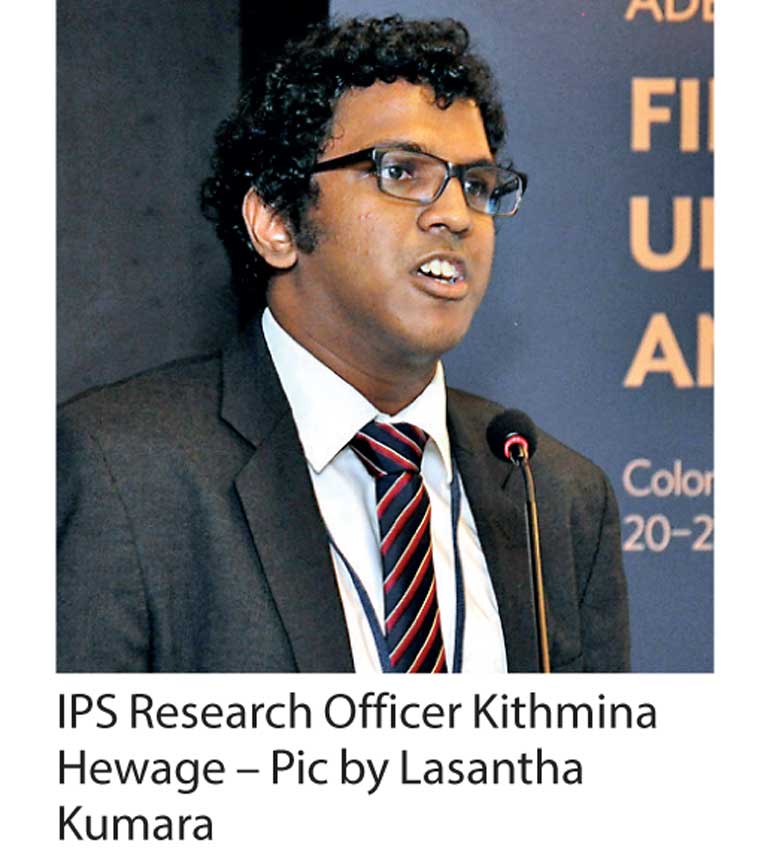Monday Apr 07, 2025
Monday Apr 07, 2025
Friday, 22 September 2017 00:00 - - {{hitsCtrl.values.hits}}
 By Charumini de Silva
By Charumini de Silva
The latest Economic Outlook of the Institute of Policy Studies (IPS) suggested there was an urgent need to “reorient” Sri Lanka’s economy towards a more sustainable means of development finance, adding that the country was in a very disadvantageous position both in terms of Government revenue and gross debt.
Concurrent to debt-led infrastructure development and low exports, it was pointed out that this has created a twin challenge for Sri Lanka in terms of stabilising the fiscal position, while catalysing and improving economic growth as a whole.
“Sri Lanka’s fiscal position is extremely poor compared to other countries at a similar economic standing. One of the main issues is that Sri Lanka has not been able to leverage its post-conflict growth dividend because of this issue of not being able to finance growth to sustain a period of time,” IPS Research Officer Kithmina Hewage said at the annual Asian Development Bank (ADB) - Asian Think Tank Development Forum 2017 in Colombo on Wednesday.
In terms of the macroeconomic overview of Sri Lanka, he said one of the most important perspectives is Government spending. “Government revenue is barely able to cover recurrent expenditure, whereas emphasis should be on capital expenditure for future returns. Primary deficits have always been around the 4% mark and crucially Government revenue mobilisation has been a key weakness when it comes to the macroeconomic policies of Sri Lanka over the years.”
He called on the Government to be responsible in how it goes about its growth strategy, particularly in financing development projects and a suggested public-private partnership (PPP) mechanism to lower the burden on the Government.
Given that the external sector was undoubtedly going to be the key driver in Sri Lanka’s economic growth going forward, it was suggested that trade policy reforms were necessary to intensify the export sector and create a more favourable environment for foreign direct investments (FDI) as well as for the ease of doing businesses.
Noting that South Asia’s intra-regional value chains are one of the weakest across the globe, he claimed that Sri Lanka has not even been able to link into global value chains due to its protectionist, nationalist ideological economic policies that led to very complex para-tariff structures that obviously increase the cost of production in the country.
“Overall we are still in an ‘ambulance’ in terms of how we see liberalisation and exports working. We are still stuck in low-skilled, labour intensive sectors rather than in productive sectors. Therefore, Sri Lanka needs an engaging strategy and basic reforms to create pertinent policies,” he added.
Considering the sectoral composition of the gross domestic product (GDP), Sri Lanka’s industrial component, including manufacturing, has been effectively leapfrogged by the services sector, but said that despite the services sector growing over the years it has not really been able to capture the potential that the country could leverage on for external sector growth in terms of FDI and export sector-led revenue.
“Services sector growth has been in domestic; non-tradables like wholesale and retail trade which account for around 25% of GDP including transport, storage and communication services that are not export revenue generating. Because of this non-tradable sector it has created severe bottlenecks in terms of how the economy grows in the middle to long term.”
It was pointed out that not only was Sri Lanka’s FDI and export performance weak, but also its structure.
He said the goods included in the export basket of Sri Lanka that was setup in 1995 and 2015 were almost identical after 20 years.
Citing an example, he explained that Vietnam made a decision on its exports and changed its priority structure which helped them to reach export revenue of $ 185 billion in 2015 from $ 5 billion in 1995, but sadly for Sri Lanka that did not change its perspective of exports which ended at $ 10 billion in 2015 from $ 3 billion in 1995.
It was highlighted that Sri Lanka failed to implement economic liberalisation policies for trade and investment as well as establish a stable environment to attract investments which support plugging into regional value chains.
Hewage suggested that if Sri Lanka was to capitalise on its regional location as well as what its potential, it was crucial to integrate into key markets like India and China.
Furthermore, he said there is growing consensus over the huge gap between the education curriculum offered and the private sector requirement, hence structural reforms to the labour market and education were also crucial.
Discover Kapruka, the leading online shopping platform in Sri Lanka, where you can conveniently send Gifts and Flowers to your loved ones for any event including Valentine ’s Day. Explore a wide range of popular Shopping Categories on Kapruka, including Toys, Groceries, Electronics, Birthday Cakes, Fruits, Chocolates, Flower Bouquets, Clothing, Watches, Lingerie, Gift Sets and Jewellery. Also if you’re interested in selling with Kapruka, Partner Central by Kapruka is the best solution to start with. Moreover, through Kapruka Global Shop, you can also enjoy the convenience of purchasing products from renowned platforms like Amazon and eBay and have them delivered to Sri Lanka.
Discover Kapruka, the leading online shopping platform in Sri Lanka, where you can conveniently send Gifts and Flowers to your loved ones for any event including Valentine ’s Day. Explore a wide range of popular Shopping Categories on Kapruka, including Toys, Groceries, Electronics, Birthday Cakes, Fruits, Chocolates, Flower Bouquets, Clothing, Watches, Lingerie, Gift Sets and Jewellery. Also if you’re interested in selling with Kapruka, Partner Central by Kapruka is the best solution to start with. Moreover, through Kapruka Global Shop, you can also enjoy the convenience of purchasing products from renowned platforms like Amazon and eBay and have them delivered to Sri Lanka.